Download CBSE Class 11 Physics Physical World And Measurement Notes Set B in PDF format. All Revision notes for Class 11 Physics have been designed as per the latest syllabus and updated chapters given in your textbook for Physics in Class 11. Our teachers have designed these concept notes for the benefit of Class 11 students. You should use these chapter wise notes for revision on daily basis. These study notes can also be used for learning each chapter and its important and difficult topics or revision just before your exams to help you get better scores in upcoming examinations, You can also use Printable notes for Class 11 Physics for faster revision of difficult topics and get higher rank. After reading these notes also refer to MCQ questions for Class 11 Physics given on studiestoday
Revision Notes for Class 11 Physics Chapter 1 Physical World
Class 11 Physics students should refer to the following concepts and notes for Chapter 1 Physical World in Class 11. These exam notes for Class 11 Physics will be very useful for upcoming class tests and examinations and help you to score good marks
Chapter 1 Physical World Notes Class 11 Physics
Science and its origin
Science is a systematic understanding of natural phenomena in detail so that it can be predicted, controlled and modified. Science involves exploring, experimenting and speculating phenomena happening around us.
- The word Science is derived from a latin verb Scientia meaning ‘to know’.
- Scientific method is a way to gain knowledge in a systematic and in-depth way. It involves:
- Systematic observations
- Controlled experiments
- Qualitative and Quantitative reasoning
- Mathematical modeling
- Prediction and verification (or falsification) of theories
- Speculation or Prediction
- Science does not have any final theory. The improved observations, accurate tools keep improving the knowledge and perspective. Johannes Kepler used Tycho Brahe’s research on planetary motion to improve Nicolas Copernicus theory.
- Quantum mechanics was developed to deal with atomic and nuclear phenomena. Work of Ernest Rutherford on nuclear model of atom became basis of quantum theory given by Niels Bohr. Antiparticle theory of Paul Dirac led to the discovery of antielectron (positron) by Carl Anderson.
Natural Sciences
Natural science is a branch of science concerned with the description, prediction, and understanding of natural phenomena, based on observational and empirical evidence. It consists of following disciplines:
- Physics
- Chemistry
- Biology
Physics
Physics is a study of basic laws of nature and their manifestation in different natural phenomena. Physics is the study of physical world and matter and its motion through space and time, along with related concepts such as energy and force.
- Word Physics is derived from a Greek word phusikḗ meaning nature.
- Two principal types of approaches in Physics are:
1. Unification: This approach considers all of the world’s phenomena as a collection of universal laws in different domains and conditions. Example, law of gravitation applies both to a falling apple from a tree as well as motion of planets around the sun. Electromagnetism laws govern all electric and magnetic phenomena.
2. Reduction: This approach is to derive properties of complex systems from the properties and interaction of its constituent parts. Example, temperature studied under thermodynamics is also related to average kinetic energy of molecules in a system (kinetic theory).
Impact and uses of Physics:
- It can explain a phenomena happening over a large magnitude with a simple theory.
- Experiments and observations are used to develop new theories for unidentified phenomena and improve old theories for existing phenomena.
- Development of devices using laws of physics.
Scope of Physics
Scope of Physics is vast as it covers quantities with length magnitude as high as 1040m or more (astronomical studies of universe) and as low as 10-14m or less (study of electrons, protons etc). Similarly the range of time scale goes from 10-22s to 1018s and mass from 10-30kg to 1055kg.
Physics is broadly divided into two types based on its scope - Classical Physics and Modern Physics. Classical physics deal with the macroscopic phenomena while the modern physics deals with the microscopic phenomena.
Macroscopic Domain
Macroscopic domain includes phenomena at large scales like laboratory, terrestrial and astronomical. It includes following subjects:
1. Mechanics – It is based on Newton’s laws on motion and the laws of gravitation. It is concerned with motion/equilibrium of particles, rigid and deformable bodies and general system of particles.
Examples,
a. Propulsion of rocket by ejecting gases
b. Water/Sound waves
c. Equilibrium of bent rod under a load
2. Electrodynamics – It deals with electric and magnetic phenomena associated with charged and magnetic bodies. Examples,
a. motion of a current-carrying conductor in a magnetic field
b. the response of a circuit to an ac voltage (signal)
c. the propagation of radio waves in the ionosphere
3. Optics – It deals with phenomena involving light. Examples,
a. Reflection and refraction of light
b. Dispersion of light through a prism
c. Colour exhibited by thin films
4. Thermodynamics – It deals with systems in macroscopic equilibrium and changes in internal energy, temperature, entropy etc. of systems under application of external force or heat. Examples,
a. Efficiency of heat engines
b. Direction of physical and chemical process
Microscopic Domain
Microscopic domain includes phenomena at minuscule scales like atomic, molecular and nuclear. It also deals with interaction of probes like electrons, photons and other elementary particles. Quantum theory has been developed to handle these phenomena.
Factors responsible for progress of Physics
- Quantitative analysis along with qualitative analysis.
- Application of universal laws in different contexts.
- Approximation approach (complex phenomena broken down into collection of basic laws).
- Extracting and focusing on essential features of a phenomenon.
Hypothesis, Axiom and Models
a) Hypothesis is a supposition without assuming that it is true. It may not be proved but can be verified through a series of experiments.
b) Axiom is a self-evident truth that it is accepted without controversy or question.
c) Model is a theory proposed to explain observed phenomena.
d) Assumption is the basis of physics, where a number of phenomena can be explained. These assumptions are made from experiments, observation and a lot of statistical data.
Technological applications of Physics
Several examples where Physics and its concepts have led to discoveries/inventions are listed below.
- Steam engine was developed from the industrial revolution in eighteenth century.
- Wireless communication was developed after discovery of laws of electricity and magnetism.
- Neuron-induced fission of uranium, done by Hahn and Meitner in 1938, led to the formation of nuclear power reactors and nuclear weapons.
- Conversion of solar, wind, geothermal etc. energy into electricity.
Fundamental Forces in nature
The forces which we see in our day to day life like muscular, friction, forces due to compression and elongation of springs and strings, fluid and gas pressure, electric, magnetic, interatomic and intermolecular forces are derived forces as their originations are due to a few fundamental forces in nature.
A few fundamental forces are:
1. Gravitational Force: It is the force of mutual attraction between any two objects by virtue of their masses. It is a universal force as every object experiences this force due to every other object in the universe.
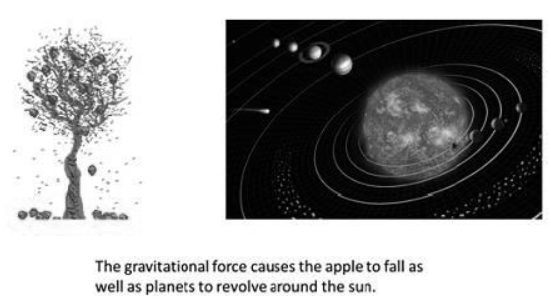
2. Electromagnetic Force: It is the force between charged particles. Charges at rest have electric attraction (between unlike charges) and repulsion (between like charges). Charges in motion produce magnetic force. Together they are called Electromagnetic Force.
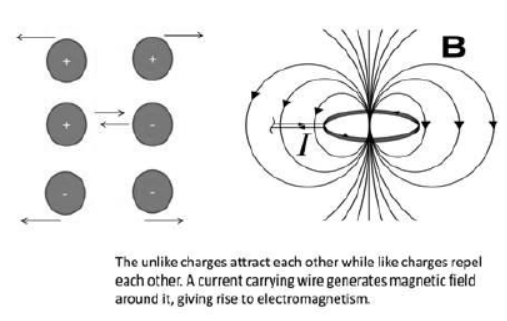
3. Strong Nuclear Force: It is the attractive force between protons and neutrons in a nucleus.It is chargeindependent and acts equally between a proton and a proton, a neutron and a neutron, and a proton and a neutron. Recent discoveries show that protons and neutrons are built of elementary particles, quarks.
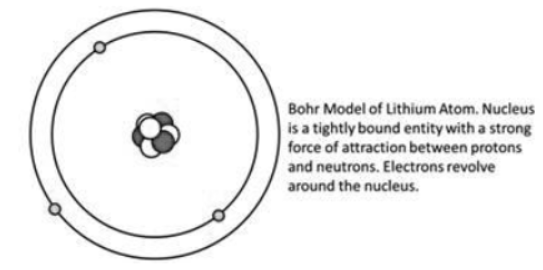
4. Weak Nuclear Force: This force appears only in certain nuclear processes such as the β-decay of a nucleus. In β-decay, the nucleus emits an electron and an uncharged particle called neutrino.This particle was first predicted by Wolfgang Pauli in 1931.
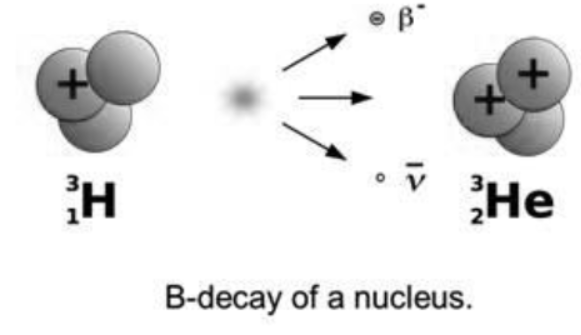
Below table shows difference between the above forces.
| Name | Relative Strength | Range | Operates among |
| Gravitational force | 10–39 | Infinite | All objects in the universe |
| Weak nuclear force | 10–13 | Very short, Sub-nuclearsize (-10-16m) | Some elementary particles, particularly electron and neutrino |
| Electromagnetic force | 10–2 | Infinite | Charged particles |
| Strong nuclear force | 1 | Short, nuclear size (-10- 15m) | elementary particles |
5. Unification of Forces: There have been physicists who have tried to combine a few of the above fundamental forces. These are listed in table below.
| Name of Physicist |
| Achievement in Unification | ||
| Isaac Newton | 1687 | Unified celestial and terrestrial mechanics. | ||
| Hans Christian Oersted and Michael Faraday | 1820 and 1830 respectively | Unified electric and magnetic phenomena to give rise to electromagnetism. | ||
| James Clerk Maxwell | 1873 | Unified electricity, magnetism and optics to show that light is an electromagnetic wave. | ||
| Sheldon Glashow, Abdus Salam, Steven Weinberg | 1979 | Gave the idea of electro-weak force which is a combination of electromagnetic and weak nuclear force. | ||
| Carlo Rubia, Simon Vander Meer | 1984 | Verified the theory of elctro-weak force. |
Conserved Quantities
Physics gives laws to summarize the investigations and observations of the phenomena occurring in the universe.
- Physical quantities that remain constant with time are called conserved quantities. Example, for a body under external force, the kinetic and potential energy change over time but the total mechanical energy (kinetic + potential) remains constant.
- Conserved quantities can be scalar (Energy) or vector (Total linear momentum and total angular momentum).
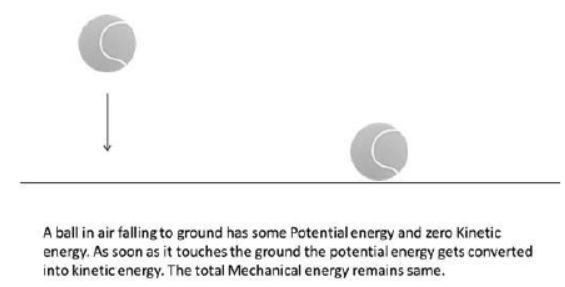
Conservation Laws
A conservation law is a hypothesis based on observation and experiments which cannot be proved. These can be verified via experiments.
Law of conservation of Energy
- According to the general Law of conservation of energy, the energies remain constant over time and convert from one form to another.
- The law of conservation of energy applies to the whole universe and it is believed that the total energy of the universe remains unchanged.
- Under identical conditions, the nature produces symmetric results at different time.
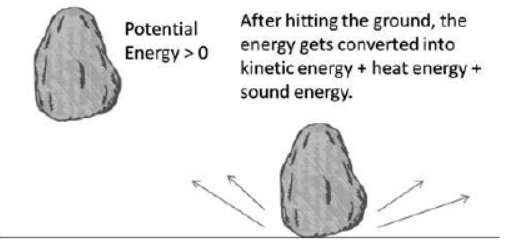
Law of conservation of Mass
This is a principle used in analysis of chemical reactions.
- A chemical reaction is basically a rearrangement of atoms among different molecules.
- If the total binding energy of the reacting molecules is less than the total binding energy of the product molecules, the difference appears as heat and the reaction is exothermic.
- The opposite is true for energy absorbing (endothermic) reactions.
- Since the atoms are merely rearranged but not destroyed, the total mass of the reactants is the same as the total mass of the products in a chemical reaction.
- Mass is related to energy through Einstein theory, E = mc2, where c is the speed of light in vacuum
Law of conservation of linear momentum
- Symmetry of laws of nature with respect to translation in space is termed as law of conservation of linear momentum.
- Example law of gravitation is same on earth and moon even if the acceleration due to gravity at moon is 1/6th than that at earth.
Law of conservation of angular momentum
Isotropy of space (no intrinsically preferred direction in space) underlies the law of conservation of angular momentum.
- Science is a systematic way of acquiring knowledge about the surroundings through careful observations and experimentations over a period of time.
- The study of nature and natural phenomenon put in an organized way in various subtopics is called physics. It has many branches namely, mechanics, electricity, magnetism, optics, modern physics, etc.
- Physics covers a tremendous range of magnitude of physical quantities such as length, mass, time, energy, etc.
- The connection between physics and technology can be observed in many examples.
- Carnot’s theory of heat engine enabled man to develop refrigerators, engine, air conditioner, etc.
- Study of electromagnetic waves and propagation helped man to design communication systems.
- The idea of the nucleus and the energy embedded in it enabled him to generate an enormous amount of energy.
- Physics and technology are related to each other.
Physics in relation to society:
Physics has tried to help humankind to develop better ideas. Development of the transport system and communication system has brought the world closer.
Fundamental forces in nature:
- Gravitational force: The gravitational force exists between any two objects in the universe. It states that the force of mutual attraction is directly proportional to the product of the masses and inversely proportional to the square of the separation.
- Electro-magnetic force: The electromagnetic force is between a pair of charges/poles. The electric and magnetic forces are not separable.
- Strong-nuclear force: The strong nuclear forces bind the protons and neutrons in a nucleus.
- Weak-nuclear forces: The weak nuclear forces appear in certain interactions such as β- decay and exist in distances of the order of 10–15 m.The electromagnetic and the weak nuclear forces are unified into one force called electro-weak force.
- Conserved Quantities: The quantities that remain constant with time for a system.
- Conservation law: Some of the general laws in nature include the laws of conservation of mass, energy, linear momentum, angular momentum, charge, parity, etc. Some conservation laws are true for one fundamental force but not for the other.
- Law of Conservation of Energy: For motion under an external conservative force, the total mechanical energy (that is the sum of kinetic and potential energy of a body) remains constant.
- Law of Conservation of Linear Momentum: In the absence of an external force, the linear momentum of a system remains unchanged.
- Law of Conservation of Angular Momentum: If the total external torque acting on a system is zero, then angular momentum of the system remains constant.
- Law of Conservation of Charge: Charges are neither created nor destroyed, but are simply transferred from one body to another
| CBSE Class 11 Physics Unit and Measurement Notes Set A |
| CBSE Class 11 Physics Unit and Measurement Notes Set B |
| CBSE Class 11 Physics Units And Measurements Notes |
| CBSE Class 11 Physics Motion In A Straight Line Notes Set A |
| CBSE Class 11 Physics Motion In A Straight Line Notes Set B |
| CBSE Class 11 Physics Motion In Plane Notes |
| CBSE Class 11 Physics Work Energy And Power Notes Set A |
| CBSE Class 11 Physics Work Energy And Power Notes Set B |
| CBSE Class 11 Physics Mechanical Properties Of Solids Notes Set A |
| CBSE Class 11 Physics Mechanical Properties Of Solids Notes Set B |
| CBSE Class 11 Physics Thermodynamics Notes Set A |
| CBSE Class 11 Physics Thermodynamics Notes Set B |
| CBSE Class 11 Physics Thermodynamics Notes Set C |
| CBSE Class 11 Physics Mathematical Tools Notes Set A |
| CBSE Class 11 Physics Mathematical Tools Notes Set B |
| CBSE Class 11 Physics Study Material All Chapters Set A |
| CBSE Class 11 Physics Study Material All Chapters Set B |
| CBSE Class 11 Physics Study Material All Chapters Set C |
| CBSE Class 11 Physics Physical World And Measurement Notes Set A |
| CBSE Class 11 Physics Physical World And Measurement Notes Set B |
CBSE Class 11 Physics Chapter 1 Physical World Notes
We hope you liked the above notes for topic Chapter 1 Physical World which has been designed as per the latest syllabus for Class 11 Physics released by CBSE. Students of Class 11 should download and practice the above notes for Class 11 Physics regularly. All revision notes have been designed for Physics by referring to the most important topics which the students should learn to get better marks in examinations. Our team of expert teachers have referred to the NCERT book for Class 11 Physics to design the Physics Class 11 notes. After reading the notes which have been developed as per the latest books also refer to the NCERT solutions for Class 11 Physics provided by our teachers. We have also provided a lot of MCQ questions for Class 11 Physics in the notes so that you can learn the concepts and also solve questions relating to the topics. We have also provided a lot of Worksheets for Class 11 Physics which you can use to further make yourself stronger in Physics.
You can download notes for Class 11 Physics Chapter 1 Physical World for latest academic session from StudiesToday.com
Yes, the notes issued for Class 11 Physics Chapter 1 Physical World have been made available here for latest CBSE session
There is no charge for the notes for CBSE Class 11 Physics Chapter 1 Physical World, you can download everything free of charge
www.studiestoday.com is the best website from which you can download latest notes for Chapter 1 Physical World Physics Class 11
Come to StudiesToday.com to get best quality topic wise notes for Class 11 Physics Chapter 1 Physical World

